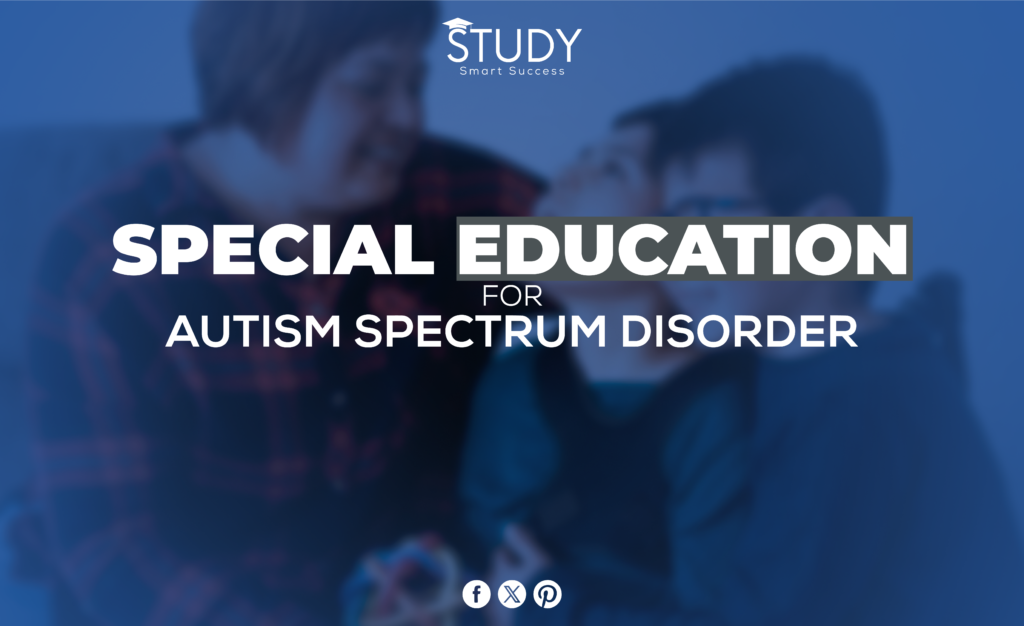Introduction
Autism Spectrum Disorder (ASD) is a group of neurodevelopmental conditions that make it hard to communicate and connect with other people. Limited or repetitive hobbies and behaviors mark them. The word “spectrum” in ASD refers to the fact that each person with autism has a wide range of skills and weaknesses. Not only is special schooling an option for people with ASD, but it’s also a requirement. It gives them personalized learning environments, lessons, and methods to fit their specific needs, making the most of their skills and helping them grow in the best way possible.
Kids with ASD need to get specialized schooling. It helps them develop personal growth, social skills, freedom, and intellectual skills for a happy life. This blog talks about the essential parts of special education for people with ASD, including the methods, problems, and wins of this vital field.
Please read our blog on the Top 13 categories of Special Education.
Understanding Autism Spectrum Disorder (ASD)
Autism Spectrum Disorder is a complicated developmental disorder that has different effects on different people. Even though they have problems, many people with ASD have unique skills and points of view. This shows how important it is to have an education system that helps them reach their full potential while solving their issues.
Definition and Characteristics
Autism Spectrum Disorder (ASD) is a “spectrum condition” that affects people in different ways and to different degrees. People with this disorder often have trouble communicating and interacting with others, and they tend to stick to the same behaviors, hobbies, or activities over and over again.
Spectrum Nature and Educational Implications
Spectrum autism means that no two people with autism are the same. Because of this, education needs to be very specific, with Individualized Education Programs (IEPs) that fit each student’s needs, skills, and hobbies.
Statistics
New studies show that about 1 in 54 children in the United States alone have ASD. Boys are nearly four times more likely than girls to be identified with autism. These numbers show how important it is to have successful special education programs that are made to fit the unique needs of kids with ASD.
Challenges in Traditional Education Settings
Because of their unique needs and ways of learning, students with ASD often can’t be met in traditional school settings.
Social Interaction Difficulties
Many people with ASD have trouble interacting with others, which can make the social setting of a regular classroom hard to handle. This can make them feel alone and anxious, which makes it harder for them to learn.
Sensory Sensitivities
A lot of people with ASD are sensitive to different sounds, lights, and smells, and some of these things can make them feel bad. It can be hard to handle in a regular classroom that wasn’t built with these needs in mind.
Need for Structure and Routine
Most of the time, students with ASD do best in organized settings with set routines. The changing and unpredictable nature of standard school situations can confuse students, making it harder for them to concentrate and learn.
Principles of Special Education for ASD
Special education for students with ASD is based on a few basic ideas that are meant to meet the specific needs of these students. These concepts ensure that education is easy to get, functional, and good for their growth.
Individualized Education Programs (IEPs)
Individualized Education Plans (IEPs) are the most critical part of special education for kids with ASD. These are personalized plans made by teachers, tutors, parents, and sometimes students. They spell out the exact goals and techniques and help the student’s needs. IEPs are living documents reviewed and changed to keep up with the student’s growth and changing needs.
Focus on Social Skills and Communication
Because people with ASD have trouble communicating and interacting with others, special education puts a lot of stress on helping them improve these skills. Students learn how to get along with others, read body language, and use language correctly by having organized learning chances and getting help.
Incorporating Interests and Strengths
In special education for ASD, one effective method is to use the student’s hobbies and skills to help them learn. This method not only makes people more interested and motivated, but it also gives them a way to comprehend other skills. For example, a student interested in trains could use that interest to help them learn math, reading, and history.
Unique Education Methods and Approaches
To successfully teach students with ASD, many specific methods and techniques have been created. These methods fit their particular ways of learning, physical needs, and growth goals.
Applied Behavior Analysis (ABA)
A lot of people with ASD are taught using ABA, which focuses on changing specific behaviors by using reward techniques. This method works very well for teaching new skills, eliminating harmful habits, and encouraging good ones.
Speech and Language Therapy
A lot of people with ASD have trouble communicating. Speech and language treatment helps people with these problems share better through words, body language, and social situations. Therapists help people improve their ability to talk to others, understand them, and use words in different situations.
Occupational Therapy
Occupational therapy (OT) helps people with ASD get better at things like eating, writing, and getting dressed. OT also works on problems with integrating sensory information and helps students deal with sensory issues that might impact their behavior and learning ability.
Social Skills Training
People with ASD are taught how to connect with others healthily through social skills training. Some things that can help with this are reading social cues, taking turns talking, and learning to understand how others feel. People are often taught these skills in groups, which makes it safe to practice and learn.
Use of Technology in Education
Technology is a big part of special schooling for kids with ASD. Technology that helps people do things, like conversation aids, social story apps, and teaching software, is beneficial. These tools can help people learn better, give them more ways to communicate, and help them improve their social and intellectual skills.
The Role of Parents and Caregivers
Parents and other adults who care for children with ASD are critical to their schooling. Their participation, lobbying, and support are essential for overcoming tough spots and enjoying the wins.
Importance of Involvement and Advocacy
Parents often look out for their kids’ best interests and work hard to ensure they get the help, tools, and chances they need. Parental involvement in IEP meetings, regular communication with teachers, and speaking up for their child’s needs can make a big difference in their child’s educational experience.
Strategies for Supporting Learning at Home
Another important thing that parents and teachers do is help kids learn at home. This can be done by setting up structured routines, ensuring the place for learning is comfortable for all senses, and doing educational tasks similar to how they are done in the classroom. It’s important to remember that practicing social and conversation skills in real life helps you use them outside of school.
Challenges and Considerations for the Future
Special education for people with ASD has come a long way, but there are still some problems that need to be fixed, and new ideas need to be found.
Funding and Resource Availability
There needs to be more money, and tools are one of the most critical problems. It can be challenging to ensure that all children with ASD receive the specific resources and care they need, especially in underfunded school districts or places with few qualified professionals. It is essential to fight for more money and resources.
Training for Educators
Special education programs depend greatly on the teachers’ and workers’ training and skills. Professional growth is vital for updating these people with the latest techniques, tools, and knowledge about ASD. Training teachers not only improves the level of education but also helps the health and happiness of the people working there.
Need for Inclusive Education Policies
Inclusive education strategies are crucial for including students with ASD in conventional classrooms when appropriate. Strong support structures are necessary for kids to thrive in less rigid settings while receiving specialized assistance.
Conclusion
ASD special education is a diverse and developing discipline based on the premise that each individual with ASD has strengths and shortcomings. We’ve found that these students need specific approaches, custom teaching tactics, and dedicated teachers and therapists to succeed.
When looking ahead, the problems of money, tools, and training will still be big ones. As long as individuals strive for it, study, and make new rules, ASD special education has a bright future. ASD accessibility and efficacy require new tools, open education ideas, and teacher learning.
Finally, special education for people with Autism Spectrum Disorder is an important area that is constantly changing. It demonstrates a commitment to understanding and fulfilling ASD students’ needs, empowering them to succeed. Time will help people understand and support ASD, and we believe special education will enhance outcomes for all autistic persons.


